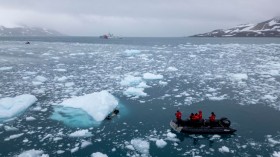Bacteria behave differently in space than on Earth, according to a new NASA-funded study from Rensselaer Polytechnic Institute located in Troy, New York.
The team, led by faculty member Cynthia Collins, sent the experiment into orbit aboard space shuttle Atlantis in 2010 and 2011, during which time samples of the bacteria Pseudomonas aeruginosa were cultured for three days in artificial urine.
Artificial urine was chosen as a growth medium because it is a physiologically relevant environment of the study of biofilms formed inside and outside the body in addition to the importance of waste and water recycling systems to long-term spaceflight, Collins explained.
Each vial of the bacteria also contained a cellulose membrane designed to act as a surface on which the biofilms could grow. These were then examined using a number of lab techniques to determine bacterial volume, among other features.
Additionally, the researchers used confocal laser-scanning microscopy to capture detailed high-resolution images of the biofilm's internal three-dimensional structure.
In doing so, the scientists found that the space-grown communities of bacteria, called biofilms, formed a "column-and-canopy" structure never seen on Earth. Additionally, biofilms grown during spaceflight had a greater number of live cells, more biomass and were thicker than control biofilms grown on Earths' gravity.
"Biofilms were rampant on the Mir space station and continue to be a challenge on the [International Space Station], but we still don't really know what role gravity plays in their growth and development," Collins, assistant professor in the department of chemical and biological engineering, said in a press release. "Our study offers the first evidence that spaceflight affects community-level behaviors of bacteria, and highlights the importance of understanding how both harmful and beneficial human-microbe interactions may be altered during spaceflight."
Beyond its importance for space travel, however, the study could lead to new methods for preventing and treating human disease on Earth by offering new insight into the effects of gravity, fluid dynamics and nutrient and bacterial growth and formation, according to the scientists. Furthermore, Collins said, the findings could one day help inform new approaches for curbing the spread of infections in hospitals.
Because there is no substitute on Earth for true microgravity conditions, labs designed to simulate it invariably fall short, according to Macarena Parra, who served as the study's payload science adviser at NASA's Ames Research Center in California.
"The opportunity to conduct microbiology research aboard spacecraft is valuable and unique," she explained.
Looking forward, the team is working to understand what exactly is taking place inside these oddly shaped biofilms. To do this, the scientists will investigate the bacteria's gene expression related to metabolism and virulence as well as build mathematical models to help understand how different factors of the spaceflight environment may impact biofilm growth.
"Before we start sending astronauts to Mars or embarking on other long-term spaceflight missions," Collins said, "we need to be as certain as possible that we have eliminated or significantly reduced the risk that biofilms pose to the human crew and their equipment."
© 2024 NatureWorldNews.com All rights reserved. Do not reproduce without permission.





